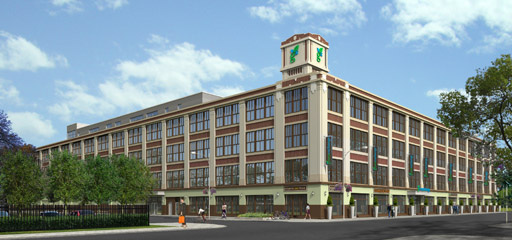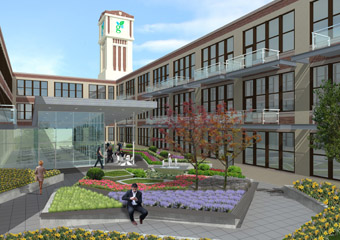Historical Preservation Meets Green Innovation
Permanent link All Posts

A rendering of what the building will look like upon completion
It’s impossible to turn on the TV or open a magazine without hearing about going green, sustainability, hybrid cars and other issues related to the environment. Today, it’s easy to find organic produce and green cleaning products at most grocery stores and there are entire stores that only sell items made from recycled or repurposed materials. With all the hype, it might be tempting to buy new counter cleaner and call it a day. But in Logan Square, neighbors and business owners are getting together to make sure that going green is more than a trend.
The massive warehouse at 2545 West Diversey has been a landmark in the Logan Square neighborhood since it was erected at the turn of the 20th century. Throughout the years, it has been a vital source of employment for the community and a driving force in the local economy. It has survived different owners and changing work environments and today, the building is going green.
Built by the Vasser Swiss Underwear Company to house “the finest knitting mill in the world,” during its heyday, the factory employed over 1,000 people. The mill was equipped with its own power plant, area for coal storage, laboratories and a clock tower. It was one of the first to provide space for employees to eat and take breaks. The company produced a variety of undergarments up until 1967 when Frederick Cooper Lamps purchased the factory to manufacture its high-end lamps. In 2005, Frederick Cooper Lamps closed the factory and put the building up for sale.
Upset over the loss of jobs in the community, neighbors organized to create the Cooper Lamps Task Force to keep the building from being turned into condominiums. With the support of 1st Ward Alderman Manuel Flores, the building was sold to Baum Development, a real estate development company recognized for its expertise in adaptive reuse and acclaimed for its preservation of historic landmarks. Co-founders Doug and David Baum bought the building initially unsure of how to develop it, but recognizing its “great bones,” Doug and David Baum promised that the building’s purpose would be to revitalize the area economy.
Green Exchange
The new concept for the building originated with Barry Bursak, a local longtime environmentalist who saw potential in such a large space. According to David Baum, “[Barry] was envisioning a green marketplace where he could house his sustainable furniture store alongside other eco-friendly businesses.” Bursak envisioned a green building that would encourage the creation and development of different types of green industries. While the brothers had never developed a green building, the concept of a totally green space immediately appealed to them. Having grown up in a household that emphasized recycling, they had always been passionate about environmental issues.
“My mother was a school teacher and a big proponent of taking care of the environment,” says Baum. “I have clear memories of driving to the recycling center with my mom so that my brother [Doug] and I could throw glass bottles into the recycling bins. We thought it was a blast, but it also had a lasting effect on how we live and work. Being an environmental steward has long been a part of my life experience, and my brother and I carried that ethos into both our personal and professional lives. And now that we both have children, the health and welfare of this planet and the condition in which we leave it is even more important.”
The two realized that going green was the next evolution in their business plan. The company has what it calls a “triple bottom line approach.” Meaning that their measure of success is not only a financial return on investment, but also an examination of how the project contributed to the community and how it protected the environment through sustainable development.
Baum explains, “Green Exchange is a prime example of this approach as we are, without a doubt, in this venture to make money, but we are working closely with the local community to create green collar jobs and revitalize the area economically. Finally, from an environmental perspective, the building is aspiring to LEED Platinum status which is the highest level of certification available for green buildings.”
Construction still has to be completed on the site before the building will become the sixth in Chicago to receive its LEED Platinum status; but it has already been rewarded with another impressive designation---historical landmark status, which seems a bit incongruous. A building that receives historical landmark status, it goes without saying, is pretty old. The use of sustainable green technology usually happens within the framework of new construction. The Baum brothers have managed to do both.
Ninety-five percent of the original structure will remain intact. By cutting down on the tons of waste normally produced in a tear down, this building has turned into one big recycling project. Just by adapting the building and re-using the space, it is already well on its way to going green.
A marriage between historic and green has equaled huge savings for the future Green Exchange businesses and their customers. Tenants will benefit from Class L tax incentives that significantly reduce property taxes for historical landmarks. In addition, LEED Platinum building will lower all utility costs due to the highly insulated walls and roofs combined with 600 high-performance windows. In addition, a sophisticated HVAC system will allow for individualized temperature control of tenant spaces, cutting down on individual energy consumption.
“One discovery we made is that a green escalator that incorporates occupancy sensors and varying speeds – using 30% less energy than a traditional escalator,” says Baum. “In addition to cool new features there are green options that are being re-discovered. For example, we will be using a 41,000-gallon rain cistern to irrigate the green roof and sky garden. While some of the technology used to predict rainfall and to pull the water from the basement to the roof is modern, the concept of gathering rain for re-use goes back to ancient civilizations. It’s a lovely blend of the past and the future.”

The sky garden adjacent to the organic restaurant
Inside the Space
Slated to open in the spring of 2009, the 272,000 square-foot building will be the largest eco friendly building in the country. “This will be the healthiest building you can build,” explains Jennifer Schellinger, director of marketing and PR for Green Exchange. Currently, there are six green businesses with plans to move into the space ranging from a packing company that uses sustainable handmade products to a marketing company that specializes in green services. There will also be an organic restaurant adjacent to an 8,000 square foot sky garden and a parking lot with priority spots designated for low-emitting vehicles.
The building will also be able to accommodate entrepreneurs and small businesses that want to be in a green environment, but don’t necessarily need a large, freestanding store. These turn-key type spaces will be equipped with many amenities including an option to rent a space that includes living quarters. The current plan offers any tenant the opportunity to work and live in the same environmentally friendly building.
“The lofts offer the perfect amount of seclusion and interaction, as you are neighbors with some of the world’s most pioneering green businesses, said Schellinger. “You’ll be exposed to myriad networking events, marketing opportunities, educational seminars and eco-leader speaker series as a tenant of the Green Exchange.”
The future of green
Cautiously optimistic about the success of the project, Baum Development hopes to develop similar buildings on a much larger scale. “Green Exchange will hopefully be a business model for the planet,” says Schellinger. And locally, there are plans in place to create an educational center within the building to help educate the city of Chicago about how to live green lifestyles.
“We are creating a one-stop environment where people can learn about green initiatives and the latest innovations, where they can purchase green goods and services and where they can meet and mingle with others who have similar goals and objectives,” says Baum.
According to Baum, the green movement is here to stay. “The future is bright green. This has moved beyond the trend phase and into the mainstream consciousness; we have no choice … attention needs to be paid and changes need to happen if we want our children and our children’s children to inherit a healthy planet.”



.jpg)



